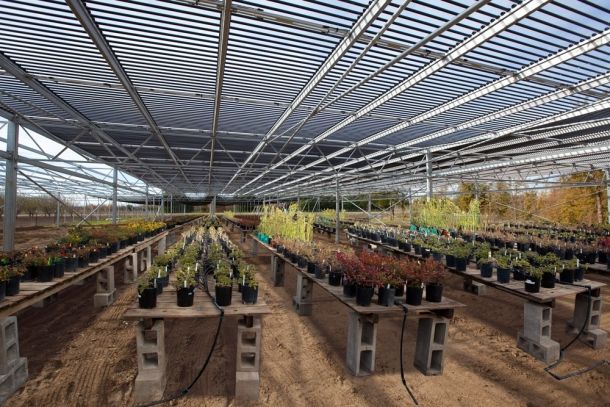Analysts and skeptics have repeatedly questioned whether Solyndra can produce tubular copper indium gallium selenide (CIGS) solar modules that compete with standard modules, but you've got to give the company points for creativity.
Today, the company showed off a solar roof made from its panels. The solar tubes harvest sunlight, which gets converted to electricity, and the light that falls between the tubes illuminates the space below. It has built a trial roof at the University of California Davis and will try it on greenhouses in Italy. Conceivably, it could be used on office buildings (picture below).
The roof, ironically, does not play into Solyndra's strengths. The tubular solar panels are supposed to harvest light that bounces off the surface of the roof directly beneath it. However, it could work to Solyndra's advantage in other ways. The company has already won a private letter ruling from the IRS that allows customers to qualify for a 30 percent investment tax credit for both its solar panels and a new roof. In most cases, the customer doesn't get the tax credit for the new roof. The extra tax credit makes Solyndra's solution more economical than regular panels in some situations, according to one developer. (Sanyo, which makes a double-sided solar panel, may seek a similar ruling.)
The roof/solar array shown here could qualify for similar tax credits. In Italy, there is a higher solar credit for greenhouse applications. President Obama recently proposed tax credits for building efficiency. France offers premium credits for building-integrated photovoltaics. By packaging its product in this manner, Solyndra may be able to capitalize on more credits than the average bear. CEO Brian Harrison has also said the company will reduce the cost of its panels by half in 2012. By the end of 2012, Solyndra systems could sell for $2 a watt, all in, he said. Stay tuned.
Elsewhere:
--Google tomorrow will showcase a startup at its headquarters that "has a technology that will drastically reduce power waste from servers, computers, industrial equipment, electric vehicles and solar panels. You will hear from prominent investors and the company CEO on the market for power waste solutions and how this company is redefining electric power conversion."
Google Ventures has an investment in the unnamed company. My guess: It has something to do with using DC in data centers. DC drastically reduces the power consumption of data centers by reducing the number of conversions power has to go through before a server or storage system consumes it. (Last month, General Electric bought Lineage Power Holdings, which specializes in DC data centers and efficient AC to DC equipment, for $520 million.) DC power also reduces real estate and maintenance costs. Note the phrase "redefining electric power conversion" in the invitation.
Both Validus DC Systems (see article here) and Nextek Power Systems are rising startups in this area. Validus already works with IBM and Oracle-Sun, while Nextek plays host to visiting dignitaries from South Korea, Japan and China on a regular basis. SAP just converted the data center in its Palo Alto facility to DC power. Either one of these could be the company being shown off tomorrow but Validus seems a little more likely of the two because of its work with the other server giants.
Are there other technologies Google could show off tomorrow? Sure. Green IT is one of the biggest markets out there these days. Companies like Sentilla, SynapSense, and Power Assure have created tools for optimizing energy consumption. SeaMicro and Calxeda are touting, respectively, energy efficient servers and chips. Alphabet Energy has waste heat converters, but the waste heat coming from servers and storage systems tends to be lukewarm and dispersed: the efficient way to recycle that energy is to pipe it into district heating systems like they do in Finland. DC just seems the most likely. (Disclosure: I'm slightly obsessed with this topic.)
--EPRI came out with a report today that said RF from smart meters is quite low, well below the thresholds set by the FCC. From the report:
"The EPRI research addressed RF from a specific type of smart meter with measurements conducted at the manufacturer’s test facility. For a continuously-operating rack of 10 meters, each operating at a nominal power rating of 250 milliwatts (typical of many residential units), the RF power density level 1 foot in front of the rack was 8 percent of the FCC limit; at 20 and 50 feet, these values dropped to 0.18 and 0.11 percent, respectively. From 8 inches behind the rack, RF power density was 0.6 percent of the FCC limit."
--Reuters says biotech crops for energy are up ten percent.




